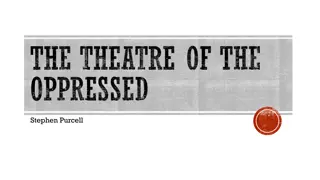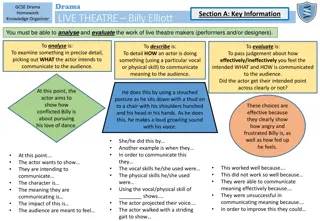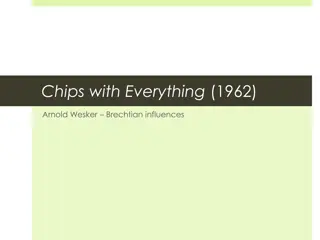Exam Preparation Strategies for DNA and Live Theatre Review
Prepare effectively for your exam by focusing on DNA concepts and live theatre review strategies, including rehearsal techniques and design elements. Learn how to approach DNA questions and craft your live theatre review effectively within the allocated time frame.
Download Presentation

Please find below an Image/Link to download the presentation.
The content on the website is provided AS IS for your information and personal use only. It may not be sold, licensed, or shared on other websites without obtaining consent from the author. Download presentation by click this link. If you encounter any issues during the download, it is possible that the publisher has removed the file from their server.
E N D
Presentation Transcript
Component 3 Revision Section A = DNA Section B = Live Theatre Review: A Christmas Carol / Things I know to be true You will have 1 hour 30 minutes for the whole exam Spend 1 hour 5 minutes answering questions on DNA (Section A) Spend 25 minutes answer the question on your live theatre review (Section B) The DNA questions are worth 45 of the 60 marks available in the paper.
The Exam You may be asked questions on your ideas for: How the play could be performed vocally and physically, using key terms to explain How the play could be rehearsed, referencing specific rehearsal techniques How the play could be designed for a named stage type, so you must have concepts for all four stage configurations How the costume/hair/make-up could be designed for each character How lighting could set the location/atmosphere/time period/season/ direct audience s attention in key moments How sound could be used to set the location/atmosphere/time period/ season/ direct the audience s attention in key moments.
Rehearsal Techniques Question The first part (i) you just need to name two and in the second part (ii) explain how it would help an actor to prepare for the scene. - If you are asked to discuss rehearsal techniques, the best way to approach them is exactly as you have in lessons. - Discuss the challenges extract/character in the question. - Explain (very briefly) rehearsal technique is/how it works. - Detail how the rehearsal technique could be used to overcome the challenge of this extract/character IN THIS SCENE. Example: (i) Name two rehearsal techniques that an actor preparing for the role of X in the extract could use. (ii) Explain how these two techniques help to prepare the actor for this role in performance. of the what the
Rehearsal Techniques The Magic If: An actor can imagine what they would do if they were in position. Adds realism to performance and helps actor to relate to performance Emotional Memory: An actor reflects on a moment in their life when they ve experienced something similar. The memory can add colour to the performance. Roots performance in the real world, therefore more naturalistic. Animal Study: An actor decides on an animal that would be similar to character. Consider how they move and interact. This may be particularly useful for helping an actor decide on their physicality and interaction. Particularly useful when they don t have many lines but need to stay alive in the scene. Masks: An actor may wear a mask during rehearsal stripping them temporarily of facial expressions. Forces an actor to be aware of how they can use their physicality to communicate, particularly useful for re-acting (e.g. Phil) Freeze Frames: Create a frozen moment in the play. Gives actors space and time to consider how they can use their physicality and the space/ levels to create meaning. Off text improvisation: Actors consider movements not included in the script to explore. E.g. perhaps how Phil and Leah met or the scene improvising the scene when Adam is attacked. Fantastic for developing the relationship between characters also adds more depth.
Rehearsal Techniques Tug of war: An actor delivers pieces of text when they are arguing whilst playing tug of war. As the intensity of the argument increases so does the their tugging. Adds tension in physicality and vocal performance. Actioning: Assign a verb to each line that an actor has to deliver their vocal delivery. Helps to ensure there is variety in the delivery of lines. Very useful when the actor has repetition of lines or large chunks of text which are in the same vein. Status Levels: An actor goes higher or lower in the scene dependent when they think that the character has more of less status. This should be non naturalistic. Chairs or tables can be used to help them get higher. This is very good for moments where there is a clear status hierarchy amongst a group. Allows the characters to consider relationships with other characters. Thought Tracking: An actor speaks their characters thoughts out loud before delivering their lines. Once they think know how their character may be feeling they can return to the scene with more intensity. Helps characters to consider their inner workings and motivation. Also they appear more alive. Also useful for when not many lines and re-acting Hot Seating: An actor sits in front of the cast and they ask them questions about their character s relationships, back story and motivations. The actor responds in character and uses their understanding of the text to improvise answers if required. Allows an actor to develop a greater understanding of their characters motivations and gives them the freedom to experiment with vocal delivery and physicality free of the constraints of the text.
Rehearsal Techniques Vocal Exercises: Carrying out exercises such as scales, tongue twisters and projection games before moving into the staging of a scene. Allows an actor to ensure that their vocal range is fully utilised. Useful for moments where the character is angry, upset or happy to ensure their voice matches. Role on the Wall: An outline of the character is stuck on the wall. The actor writes everyting the character thinks about themselves on the inside and outside all of the things said about them by other characters. A very useful way of gathering the full picture painted by the playwright. Units and Objectives: An actor splits their script up into chunks (aka units) where the topic of conversation is the same, imagining they are creating chapters in the script. These units could be whole pages or just a couple of lines. characters thoughts out loud before delivering their lines. The actor then decides what their objective is. They can use this to colour their performance in the scene. Importantly the objective must change when their unit does. Splitting it into units makes the actors look objectively at their lines and allows variety in their performance.
Answering an acting question: Use: What? Where? Why? Example: The motivation of an actor playing Phil in the group scene when he first speaks is to shock the audience by the fact that he has spoken having remained silent up until this point and then effectively demonstrate his easy control of the situation that has the other characters panicked. While he listens to the other characters I would have his posture still and he would use minimum facial expressions or gestures to make the impact of his speaking even more dramatic when he does. He would be centre stage to give a hint to the audience about his later dominance. When he speaks he could then take control. One way in which this could be achieved is in the use of the performance space. He should be central and then move towards each of the other characters as he gives them their individual instructions. This use of proxemics also clearly shows that Phil has the greater power as he chooses when the other characters are allowed to be physically close to him. He would vary his tone and volume depending on who he is giving his instruction to, for example when he speaks to Jan and Mark quotation he should etc At this point he would also vary his facial expressions to reflect the position of the other character being addressed. In an acting question you need to explicitly link your ideas to the named scene using key quotations. Consider firstly what their motivation with their character is in the scene and then link everything else to it. The bullet points will remind you to discuss motivation, voice, movement and interaction. You should use drama terminology throughout your answer.
Acting Questions: Vocal Key Terminology Accent: Changing pronunciation of words to reflect heritage, nationality or social class. Articulation: Ensuring lines are delivered clearly so that the audience understands them. Pace: The speed in which an actor delivers a line. Pitch: How high or low an actor delivers a line Projection: Ensuring a line is delivered in a way in which fits the performance space. Rhythm: The beat with which an actor delivers a line. I.e. smooth/confident or broken/ stuttered. Tone: The emotional colour an actor adds to a line which can be described in terms of emotion. Volume: How loudly an actor delivers their line.
Acting Questions: Physical Terminology Body language: the use of an actor s body to communicate how their character feels you should be able to explain how that emotion comes across. E.g. A character should have anxious body language with folded arms. Facial Expressions: The use of an actor s face to reveal how their character feels. Again link how. E.g. They should have an angry facial expression with gritted teeth. Gait: The manner in which the actor walks. It could be described as an open gait for large strides or closed gait for small steps. Link to emotions. Gestures: The use of an actors hands and/or arms to show how they are feeling. E.g. Anxious gestures like wringing his hands. Posture: The shape in which the actor holds their body to reveal their feelings. E.g. Confident posture with shoulders back and head raised high. Proxemics: How close or distant an actor stands to/from another character to reveal their relationship. Use of space: how an actor moves within the space. E.g. confidently and directly. E.g. standing in the middle of the space presents confidence where as a nervous character would stand to one side.
If you had a question on lighting Lighting can be exceptionally powerful and can be used effectively with set to create location, themes and atmosphere. Lighting Types and what each could be used for: Profile spotlight A lantern which creates a hard edged beam of light. It is good for highlighting specific areas on the stage. Fresnel Spotlight This produces a soft edged beam which is good for lighting smaller areas of stage. It is more naturalistic than a profile spotlight. Flood light Lights large areas of stage in one intensity and colour it literally floods the stage. Strobe light This special type of lantern flashes a bright light quickly on and off appearing jumpy. It can be used to create moments of high tension Moving head Versatile type of lantern that can be programmed to move so that beams of light sweep across the stage, change colour or project images. Gels These are used to change the colour of the beam. These are coloured plastic filters which are slotted at the front of lanterns. They come in many different colours. Gobos These are metal stencils which are slotted at the front of profile spotlights to project an image onto the stage. They can quickly project locations for the audience, particularly important for DNA.
Section B: Live Theatre Review Your choices: A Christmas Carol or Things I know to be True NOT DNA!!!! Remember that this is only worth 15 marks out of the 60 available therefore do not spend too long on this. You will be presented with a choice of two questions. You must only choose one to answer. Choose whichever one you think will better at. For an acting question you would need to cover how well the actors interpreted character interacted between characters demonstrated vocal skills demonstrated movement skills For a director question you would need to assess how well the director had interpreted the play s style demonstrated performance conventions demonstrated spatial relationships on stage managed the relationship between the performer and the audience For a design question you would assess how well they have created the mood and atmosphere through the use of Performance space Lighting Sound Set and props Costume and make up For ALL questions: Analyse and evaluate what made the piece of theatre successful Have a personal reaction to key moments Consider other audience members reaction to key moments Use key terminology regularly
Revision Hints: Google images of the productions that we have seen to remind you of design. Try to create a sample answer in the time constraints.
What do you need to know for your chosen performance to review: Task make sure you ve prepared ideas about these things this weekend. Acting: Vocal performance Physical performance Interaction Style Sound Volume of effects Recorded sound vs. live Editing of sounds: Echoes, speeding up or slowing down Atmosphere created Costume: Garments worn for key characters Colour of garments Fabric used Accessories Hair or wigs Period created Location created Time of year/style Condition of garments Set Lighting Colour Intensity Highlighting of specific areas with lighting Angles used and effect upon actors/ creation of shadows Specials (strobes, spotlights, projections) Time of day/season/atmosphere created Location created Colour palette used Furniture and props on stage Wall coverings Floor coverings Size of set pieces Location of set pieces Location created Period/ Time created Atmosphere created
Writing a successful review WACM (Wack em!) in every paragraph W What happened: describe a specific moment or aspect use drama or design terminology A Atmosphere: How did it impact the atmosphere C Character: What did it reveal about the character (i.e. how did the costume or prop or aspect of set or decision about voice or decision about light have an impact on how you viewed the character?) M Me: what was your/ the audience reaction or what were your thoughts?
Things I know to be True Example: Things I know to be True toured the UK in 2017. The play raises questions about what the characters actually know to be true. Character Example: Perhaps the most moving moment of the entire play was the link between the opening soliloquy of Bob and a second one in which he reveals the nature of the phone call. As the play was directed by Frantic Assembly it is physical theatre at its best. In the final scene the actor playing Bob was choreographed to lean forward defying the rules of gravity. The other characters were blacked out and the spotlight was on Bob, as they supported him to hold an impossible pose perhaps representing the extreme emotions at that moment. His facial expressions perfectly matched this as he looked out into the darkness of the audience almost pleading it not to be true. This is poignant as for most of the play Bob is presented as the most ordinary of a family full of people with emotional and logistical problems so his break down at the end is even more powerful.























